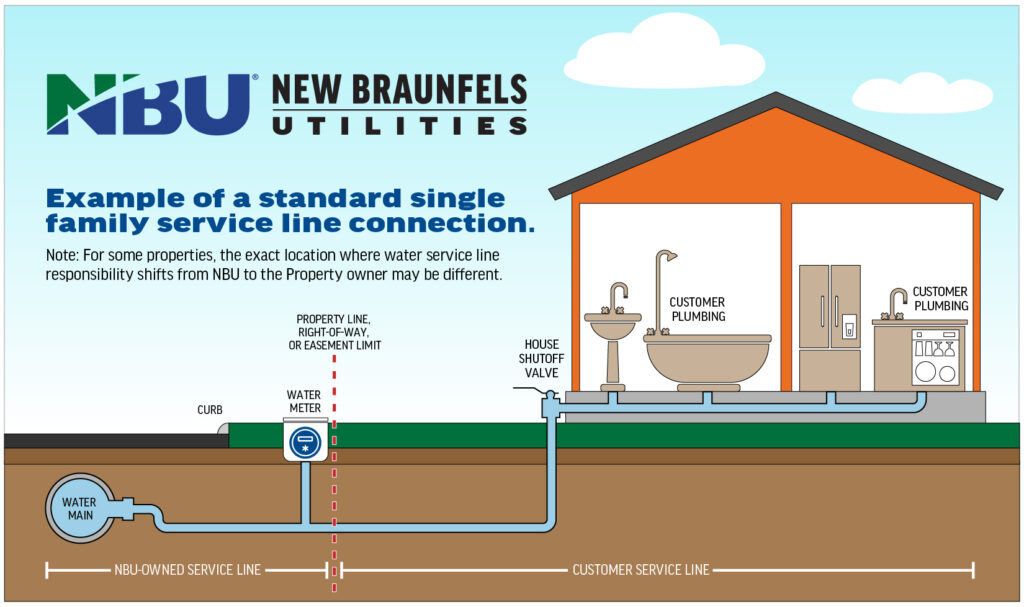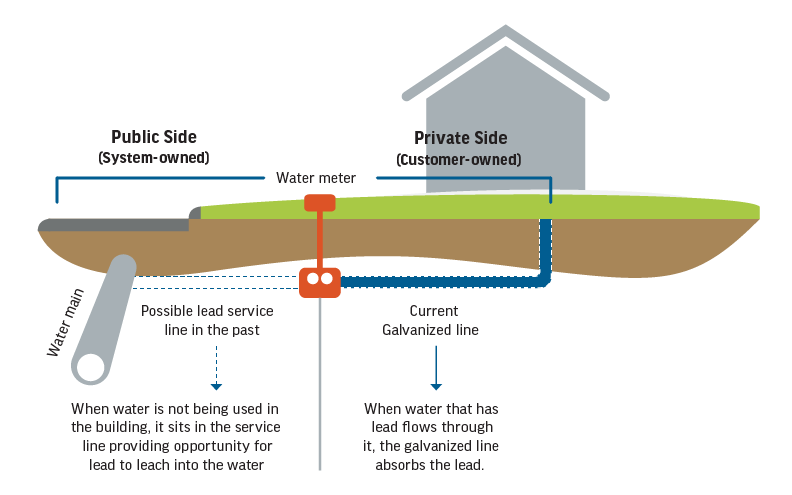Water Line Inventory
We Take Pride in Providing Safe, Clean Drinking Water
In April 2023, NBU began surveying water lines in our service territory to inventory and determine the pipe materials used to connect our water distribution system to residences or businesses. Although highly unlikely, this process will help determine if any lead pipes still exist on the customer-facing side of residences. Water service lines made of lead can affect the quality of drinking water and cause serious health effects.
This new program is in response to the Environmental Protection Agency’s 2021 Lead and Copper Rule Revisions, which require water suppliers to inventory all service lines within their service area. All service lines built before 1983 were surveyed, a timeline approved specifically for NBU by the Texas Commission on Environmental Quality. The inventory has been completed and was submitted to the Environmental Protection Agency on October 26, 2024.
What is a service line?
A service line is the piping that runs from the water main to the building inlet. New Braunfels Utilities owns the section of the service line from the road to the water meter, while the section from the water meter to the residence is owned by the customer.

A water service line (or lateral) consists of two separate pipes. One of which connects NBU’s water main to the customer’s water meter. The other part connects the water meter to the customer’s house or building.
New Braunfels Utilities is responsible for the water service from the water main to the water meter. The property owner is responsible for the water service line from the water meter to the building, including all of the service lines inside the building.
Before being prohibited by the State of Texas on July 1, 1988, lead was an acceptable material for use in water line systems. Over time, it was discovered that the use of lead in drinking water service pipes can lead to adverse health effects.
The use of lead in residential and business service lines was prohibited by Congress in 1986. However, the City of New Braunfels adopted a Plumbing Code in 1982 which did not list lead as an acceptable material for water service lines. If your residence was built before 1983, there is a chance, although very unlikely, that lead service pipes are still in use and may be affecting the quality of your drinking water.
Lead is rarely found naturally in our source water or in the treated water flowing through the NBU distribution system. More commonly, traces of lead can leach into water over time through corrosion—a dissolving or wearing away of metal caused by a chemical reaction between water and your plumbing.
Lead can leach into water from pipes, solder, fixtures, faucets (brass), and fittings. The amount of lead in your water depends on the types and amounts of minerals in the water, how long the water stays in the pipes, the water’s corrosivity, and water temperature.
No. New Braunfels Utilities employees will be surveying homes with water service lines that were installed before 1983. No action is needed on your part.
Any homes built before 1983 will have their water service line examined and surveyed. If lead materials are identified, they will be inventoried, and you will be notified.
NBU has mailed letters to all customers potentially impacted. There are two separate letters depending on your situation:
1. Lead Service Unknown water service line letter
2. Galvanized Requiring Replacement (GRR) water service line letter
New Braunfels Utilities has been sampling customers’ homes for lead and copper over the last 30 years and has never exceeded the action limit for lead or copper. The water provided to customers is considered ‘very hard’ on the hardness scale and is not corrosive. In fact, the hardness precipitates out and actually coats the interior of the pipes which prevents the leaching process from occurring.
The intent of the regulation is to replace all lead and GRR service lines over a ten-year period beginning in late 2027. NBU is required to develop a replacement plan for affected customers, details of which will be released at a later date. If you choose to replace the private side of your service line prior to the beginning of NBU’s replacement plan, please contact us at waterserviceinventory@nbutexas.com so we may coordinate efforts to replace our side if required.
No. There will never be any service disconnections as a result of this program.
NBU is in the process of developing the replacement plan which will begin in October 2027. One of the requirements of the plan is to put a strategy in place for those who cannot afford replacement.
Once the service line replacement plan is finalized and submitted to TCEQ for approval, the specifics on how and when pipes will be replaced will be shared with customers. The details are not confirmed at this time.
There are steps you can take right away to reduce the possibility of lead in your water, but if you have lead water lines, the best solution is to have them replaced.
- Run the Tap Before Use – Lead levels are likely at their highest when water has been sitting in the pipe for several hours. Clear this water from your pipes by running the cold water for several minutes, which allows you to draw fresh water from the water main. Please remember to be water wise and try not to waste water. You can use this water on house plants or to flush toilets.
- Clean Aerators – Aerators are small attachments at the tips of faucets which regulate the flow of water. They can collect small particles of lead in their screens. It’s a good idea to remove your aerators at least monthly and clean them out.
- Use Cold Water for Drinking and Cooking – Always cook and prepare baby formula with cold water, because hot water dissolves lead more quickly, resulting in higher levels in water.
- Change Out Old Fixtures – Plumbing regulations now stipulate that all fixtures must be manufactured lead-free. Consider installing new fixtures and/or pipes to eliminate sources of exposure.
- Filter the Water – Many home water filters are effective at removing lead. If you purchase a filter, make sure it is certified for lead removal and that you maintain it properly.
- Do Not Boil Water – Boiling water will not remove lead from the water.
In Texas, lead solder was commonly used to join copper pipes until 1988, when regulations limited its use. The national lead ban was enacted in Texas in June 1988, so plumbing installed before 1989 could potentially contain lead in the lines, solder, or fixtures. Licensed plumbers or home inspectors can assist in identifying your home’s plumbing materials.
If lead is detected in your drinking water, immediately reduce your exposure. Run the water tap for 2 -5 minutes before use. Use bottled water or a filter, such as a Brita filter, to remove lead for drinking and cooking. Boiling water does NOT reduce the level of lead in your water.
For more details, please refer to the question “What can I do to reduce my exposure to lead?” or visit the CDC’s website: https://www.cdc.gov/lead-prevention/prevention/drinking-water.html
First, locate your plumbing lines. They can usually be seen at the pipe entering the water heater, attic, basement, or other utility areas where pipes are exposed. A certified plumber can help perform an inspection to locate plumbing lines and identify the material. Your service line, which connects your home to the water meter, is buried and will require excavation to expose a portion of the line.
Lead is a dull, soft, non-magnetic material that turns a shiny silver when scratched. A scratch test is a quick method for identifying the service line material entering a home or building. If the scratched area turns out to be roughly the color of a penny, it is likely copper. But if it turns shiny silver, it may be lead or galvanized iron. You can place a magnet on the pipe to distinguish between lead and galvanized iron. If the magnet sticks to the pipe, it is likely iron and not lead. Once you’ve identified the material of your premise’s plumbing and/or service line, please inform your local utility.
It is the landlord’s responsibility to maintain pipes. If you are concerned about the material of the pipes, you can ask your landlord if they can perform a scratch test or have a plumber verify your line materials.
Why is my line categorized as Galvanized Requiring Replacement?
There is a potential risk for galvanized pipe to have absorbed lead if it was ever located downstream of a lead service line in the past. While your line is not currently downstream of a lead service line; NBU does not have records to prove the material of the upstream service line for the full history of your service connection. Because we don’t have full historical records, out of an abundance of caution the rule requires the line to be labeled as GRR and treated as a lead service line.

There is No Action Required on Your Part
If your home has lead or copper service lines, they will be identified by professionally trained NBU employees, and you will be notified via mailed letter. There is no action needed.
1. Lead Service Unknown water service line letter
2. Galvanized Requiring Replacement (GRR) water service line letter